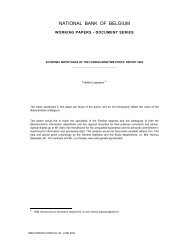A multi-factor model for the valuation and risk management of ...
A multi-factor model for the valuation and risk management of ...
A multi-factor model for the valuation and risk management of ...
Create successful ePaper yourself
Turn your PDF publications into a flip-book with our unique Google optimized e-Paper software.
Most <strong>of</strong> <strong>the</strong> controversy can be linked to <strong>the</strong> di¤erent opinions about <strong>the</strong> proper de…nition <strong>of</strong> what a<br />
deposit liability really is. For example, Barth (2005), representing <strong>the</strong> accounting rule-makers view,<br />
de…nes liabilities as "<strong>the</strong> present obligation <strong>of</strong> an entity arising from past events, <strong>the</strong> settlement <strong>of</strong><br />
which is expected to result in an out‡ow <strong>of</strong> resources from <strong>the</strong> entity". In <strong>the</strong> case <strong>of</strong> deposits, <strong>the</strong><br />
IASB believes that <strong>the</strong> present obligation arising from a past event are <strong>the</strong> actual deposited funds by<br />
a depositor <strong>and</strong> <strong>the</strong> obligations that follow from that deposit, i.e. rent due on outst<strong>and</strong>ing balances.<br />
This de…nition has important <strong>valuation</strong> implications, as existing deposits typically remain unused<br />
<strong>for</strong> a relatively short period (perhaps a few days, weeks, or months, depending on <strong>the</strong> type <strong>of</strong><br />
deposit account). Correspondingly, <strong>the</strong> value discount will indeed be negligible, as short term zero<br />
coupon bonds trade close to <strong>the</strong>ir par values.<br />
In contrast, bankers <strong>and</strong> <strong>risk</strong> managers typically argue that <strong>the</strong> past event is not <strong>the</strong> actual deposit<br />
but ra<strong>the</strong>r <strong>the</strong> establishment <strong>of</strong> <strong>the</strong> relationship with <strong>the</strong> depositor, such that new future replacement<br />
deposits are expected based on past experience that is likely to persist in <strong>the</strong> future. For example,<br />
when <strong>the</strong> bank gives a mortgage loan to a new client, it may ask <strong>the</strong> client to open a deposit account<br />
on which its salary needs to be paid. It is obvious that <strong>the</strong> implied deposit balance behavior is<br />
radically di¤erent in this case than in <strong>the</strong> more narrowly de…ned case followed by <strong>the</strong> IASB, leading<br />
to potentially very di¤erent <strong>valuation</strong> <strong>and</strong> hedging results. When <strong>the</strong> bankers’view is followed,<br />
deposit balances resemble more a perpetuity, <strong>valuation</strong> discounts are potentially large <strong>and</strong> interest<br />
rate sensitivities are relatively long.<br />
Above we already set out our opinion in this di¢ cult debate. We think it would be best to include<br />
existing deposits <strong>and</strong> future expected deposits to <strong>the</strong> extent that <strong>the</strong> latter can be identi…ed in<br />
a veri…able way. So, our view lies closer to <strong>the</strong> bankers’ view in <strong>the</strong> sense that we would also<br />
want to consider some future expected cash ‡ows (though not all), next to existing deposits only.<br />
Moreover, we do not in general support <strong>the</strong> a priori accounting rule-makers’belief that deposits<br />
typically remain unused <strong>for</strong> a short period only, <strong>and</strong> hence that <strong>valuation</strong> <strong>and</strong> hedging problems<br />
become irrelevant if one is to restrict oneself to existing deposits only. Such a belief may indeed<br />
be justi…ed <strong>for</strong> transaction deposit accounts, but need not hold in total generality. For example,<br />
Belgian savings deposits account balances may be relatively stable, even if we consider outst<strong>and</strong>ing<br />
balances only, due to <strong>the</strong> fact that (i) <strong>the</strong>y are not true transactions accounts <strong>and</strong> (ii) speci…c …scal<br />
<strong>and</strong> price regulation applies. By law, <strong>the</strong>ir renumeration should always consist <strong>of</strong> a base rate on<br />
<strong>the</strong> one h<strong>and</strong> <strong>and</strong> a loyalty or growth premium on <strong>the</strong> o<strong>the</strong>r h<strong>and</strong>. While <strong>the</strong> base rate is paid<br />
out pro rata <strong>of</strong> <strong>the</strong> number <strong>of</strong> days <strong>the</strong> deposits have been sitting in <strong>the</strong> account, growth <strong>and</strong><br />
loyalty premiums are only reaped when balances have remained in <strong>the</strong> account without interruption<br />
<strong>for</strong> relatively long periods (6 months <strong>and</strong> 1 year, typically). In return, depositors enjoy a …scal<br />
advantage as <strong>the</strong> earned rent is …scally exempt up to a certain limit.<br />
Finally, note that Euro System central banks are typically reluctant to record nonzero deposit<br />
premiums in <strong>the</strong> balance sheet. From a …nancial stability point <strong>of</strong> view, this reluctance is underst<strong>and</strong>able,<br />
as such a recording may trigger a deposit run when unsophisticated depositors observe<br />
that <strong>the</strong> bank values <strong>the</strong> debt that is owed to <strong>the</strong>m at less than <strong>the</strong> par value. In fact, many<br />
technical <strong>and</strong> supervisory working groups, amongst o<strong>the</strong>rs <strong>the</strong> European Financial Reporting Advisory<br />
Group (EFRAG) <strong>and</strong> <strong>the</strong> Basel Committee on Banking Supervision (BCBS), also agree with<br />
<strong>the</strong> IASB position that dem<strong>and</strong> deposits should be recorded in <strong>the</strong> balance sheet at face value.<br />
However, <strong>the</strong> IASB position that <strong>the</strong> fair value <strong>of</strong> dem<strong>and</strong> deposits is continuously equal to <strong>the</strong><br />
face value, even when interest rates change, remains a controversial stance. In our view, <strong>the</strong> idea<br />
that veri…able future expected deposits must be taken into account may bridge <strong>the</strong> gap between<br />
supervisors, <strong>risk</strong> managers <strong>and</strong> st<strong>and</strong>ard setters.<br />
proper accounting rules <strong>for</strong> insurance products. Similar controversies arise here between <strong>the</strong> contractual date IASB<br />
stance <strong>and</strong> <strong>the</strong> more behavioral date stance <strong>of</strong> <strong>the</strong> insurers, as one-year contracts are typically being renewed<br />
quasi-automatically <strong>for</strong> <strong>the</strong> bulk <strong>of</strong> <strong>the</strong> customer base, leading to substantially longer e¤ective time to maturities.<br />
22
















